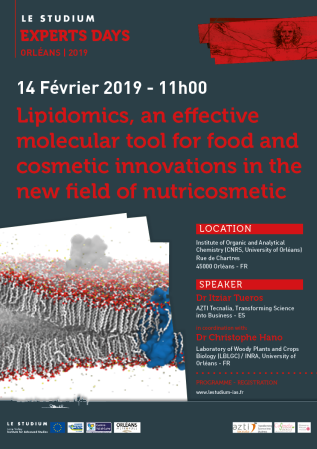Lipidomics, an effective molecular tool for food and cosmetic innovations in the new field of nutricosmetic
11h - 12h30
Institute of Organic and Analytical Chemistry (CNRS, University of Orléans)
Rue de Chartres
45000 Orléans
France
Presentation
European Industry is trying to adapt consumers’ needs into innovative products, bringing to market more convenient and safe products. At the same time, the public is advised to consume a healthy diet in order to prevent or delay the onset of chronic diseases such as obesity, skin care, diabetes and cancer. AZTI’s Food Division has a multidisciplinary team working closely with the food industry, transferring knowledge and offering integrated solutions for the development and launch into market of new food products. Current and future research in nutrition is focusing on the use of new “omics” tools (genomics, transcriptomics, proteomics and metabolomics). These tools are useful to adquire big information to better understand better metabolism and to provide new biomarker concepts and strategies to characterize and quantify physiological functions related to Food and Health. In this sense, we present membrane lipidomics as a new approach in order to draw a direct way from bioscience to food and cosmetic research for the development of personalized food products and meals but also for the development of a new nutricosmetic approach.
Lipidomics can be defined as the study of the structure and function of the complete set of lipids produced in a given cell or organism, as well as their interaction with other lipids, proteins and metabolites. Lipidomics is a relatively recent research field that has been driven by rapid advances in technologies such as mass spectrometry (MS), nuclear magnetic resonance (NMR) spectroscopy, and fluorescence spectroscopy. In our studies, we use a very precise and automatized analytical method consisting in the isolation of mature erythrocytes or red blood cells (RBC) through a patented high-throughput robotics followed by chromatographic separation (CG-MS). The mature erythrocyte provides the information of the metabolic and nutritional status occurred in the individual during a reasonable long time window (erythrocyte life-time: 120 days); it is representative of the general conditions of tissues and thus, whole organism, and its fatty acid composition includes all families (SFA, MUFA and PUFA). Monitoring of erythrocyte membrane fatty acid profile allows the molecular characterization of specific disease or health condition population groups, creating lipidomic profiles such as obesity/overweight, sport, pregnancy, aging, cancer, cardiovascular disease, dermatology, neurology or ophtalmology. This valuable information will help to design specific food and cosmetic products addressed to specific population niches. The use of membrane lipidomics in food research paves the way for the development of a new generation of food products in a personalized nutrition approach and the development of nutricosmetic.
Speaker
Dr Itziar Tueros,
AZTI Tecnalia, Transforming Science into Business - ES
in coordination with:
Dr Christophe Hano,
Laboratory of Woody Plants and Crops Biology (LBLGC) / INRA, University of Orléans - FR







